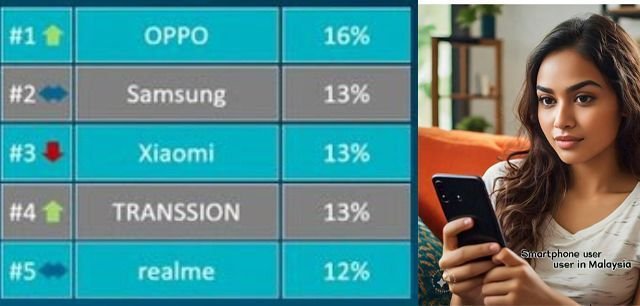The latest Canalys report has revealed the top selling smartphone brands in Malaysia during the third quarter of 2024. Key players like OPPO, Samsung, Xiaomi, and TRANSSION have contributed to the success of the devices market, leveraging both volume and value strategies.

Oppo (16 percent share), Samsung (13 percent), Xiaomi (13 percent), Transsion (13 percent) and Realme (12 percent) are the top selling smartphone brands in Malaysia in Q3 2024. Xiaomi (17 percent) was the top brand in the smartphone market in Malaysia in Q4 2023. Samsung (14 percent), Oppo (13 percent), Apple (12 percent) and Honor (11 percent) were the other top selling smartphone brands in Malaysia at the end of 2023, Canalys said.
OPPO has led the Malaysian market, mirroring its regional dominance with strong sales driven by its re-branded entry-level models like the A3x and A3. The brand has capitalized on Malaysia’s competitive pricing dynamics, offering affordable yet feature-rich smartphones. This approach has helped OPPO capture a significant share of the market, aided by their simplified entry-level offerings, which have reduced complexity and increased pricing efficiency.
Samsung, with its premiumization strategy, follows closely behind in market share. While its volume share is lower, it holds a dominant value share of 23 percent, signaling its continued focus on high-end devices and raising the average selling price (ASP) of its smartphones. The company’s ability to differentiate itself in the mid- to high-end segments with premium models has been particularly effective in Malaysia, where demand for quality and innovation remains strong. Samsung’s strategy of investing in premium experience stores and focusing on ASP growth rather than shipment growth aligns well with the shifting dynamics of the market.
Xiaomi has emerged as a notable competitor, holding 15 percent market share and growing its presence with competitively priced models like the Redmi 14C. Xiaomi’s strategic push in Malaysia in early 2024 with its premium Xiaomi 14T series has expanded its reach, making it a significant player in both the budget and mid-range markets. This expansion has helped Xiaomi capture the attention of both budget-conscious and value-driven consumers, driving volume while maintaining a solid brand presence.
TRANSSION, the third-largest player in Southeast Asia, faces a slowdown in growth as it shifts its focus from market share expansion to enhancing profitability. In Malaysia, TRANSSION has targeted the budget segment with its brands like TECNO and Itel, which offer affordable options, but the intense competition in the low-to-mid range has led to stagnation in its growth trajectory.
The Malaysian market, similar to broader Southeast Asia, has seen a 4 percent dip in ASP due to an oversupply of devices in the US$100 to US$300 range. This price pressure has led vendors to rely heavily on promotions and discounts to drive sales, though this is becoming unsustainable as rising costs impact profitability. To combat this, brands like OPPO and Samsung have streamlined their entry-level portfolios to reduce overlaps and focus on clearer product differentiation.
The rise of 5G in Malaysia is also a crucial factor for the smartphone market’s future. As network operators work with the government to expand 5G coverage, the demand for affordable 5G devices is expected to increase. Xiaomi’s success in the country is a prime example of how vendors can leverage carrier partnerships to expand accessibility to premium devices at more affordable price points.
Looking ahead, brands are expected to continue tailoring their strategies to local market dynamics in Malaysia. OPPO and Samsung’s investments in premium stores and localized strategies reflect a broader trend across Southeast Asia, as companies aim to balance mass-market volume with premium offerings. Apple, with a year-on-year growth of 34 percent in the region, also highlights the importance of capturing premium demand through retail and branded store expansions.
In summary, Malaysia’s smartphone market is evolving with strong competition among both budget and premium players, highlighting the importance of local partnerships, clear product differentiation, and adapting to the growing demand for 5G devices.
